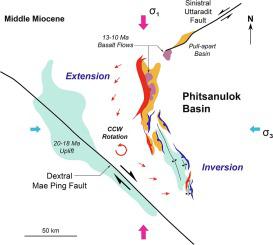Journal of Asian Earth Sciences ( IF 2.7 ) Pub Date : 2021-04-08 , DOI: 10.1016/j.jseaes.2021.104774 Sarawute Chantraprasert , Seehapol Utitsan

|
The Phitsanulok Basin is a Cenozoic rift basin in central Thailand. The basin opened in the Oligocene to Early Miocene with the development of N-S and NNW-SSE trending normal faults. In the Middle Miocene the northern part of the basin continued to experience extension, while the southern part was affected by compressive inversion. Extension resumed in the Late Miocene to Pliocene, followed by post-rift subsidence in the Quaternary. The Middle Miocene anomalous deformation is attributed to activities of the NE-SW Uttaradit Fault and NW-SE Mae Ping Fault, respectively at the northern and southern basin margins. Both faults had limited activities during the Oligocene to Early Miocene rifting, where E-W extension was probably accompanied by vertical maximum principal stress. In the Middle Miocene, the maximum principal stress rotated to a N-S direction and produced sinistral motion on the Uttaradit Fault and dextral motion on the Mae Ping Fault. The strike-slip motions contributed to a counter-clockwise rotation of the continental block west of the Phitsanulok Basin, creating the synchronous extension and contraction. The kinematic model introduces the possibility of local inversion in a rift basin being originated from short-term switch between the maximum and intermediate principal stress axes and reactivation of long-lived strike-slip faults, as opposed to major change in regional stress related to plate movements. The model implies that the segment of the Mae Ping Fault south of the Phitsanulok Basin was inactive during the Oligocene to Early Miocene and was reactivated as a dextral fault in the Middle Miocene.
中文翻译:

裂谷盆地同步伸展和反转的起源:泰国中部彭世洛盆地
彭世洛盆地是泰国中部的新生代裂谷盆地。该盆地在渐新世至中新世开放,NS和NNW-SSE的发育趋于正断层。在中新世中期,盆地北部继续扩张,而南部则受到压缩反演的影响。在中新世晚期恢复到上新世,随后在第四纪裂陷后沉降。中新世中部异常形变分别归因于北部和南部盆地边缘的NE-SW渥太华断层和NW-SE湄平断层的活动。在渐新世至中新世裂谷期间,这两个断层的活动都受到限制,在该断层中,EW扩展可能伴随着垂直最大主应力。在中新世中期,最大主应力向NS方向旋转,在程逸断裂上产生左旋运动,在湄平断裂上产生右旋运动。走滑运动促使彭世洛盆地以西的大陆块逆时针旋转,从而产生了同步的伸展和收缩。运动学模型引入了裂谷盆地局部倒转的可能性,其起源是最大和中间主应力轴之间的短期转换以及长寿命走滑断层的重新激活,而不是与板块有关的区域应力的重大变化。动作。该模型暗示,彭世洛盆地南部的湄平断层段在渐新世至早中新世期间没有活动,并在中新世中被重新激活为右旋断层。











































 京公网安备 11010802027423号
京公网安备 11010802027423号